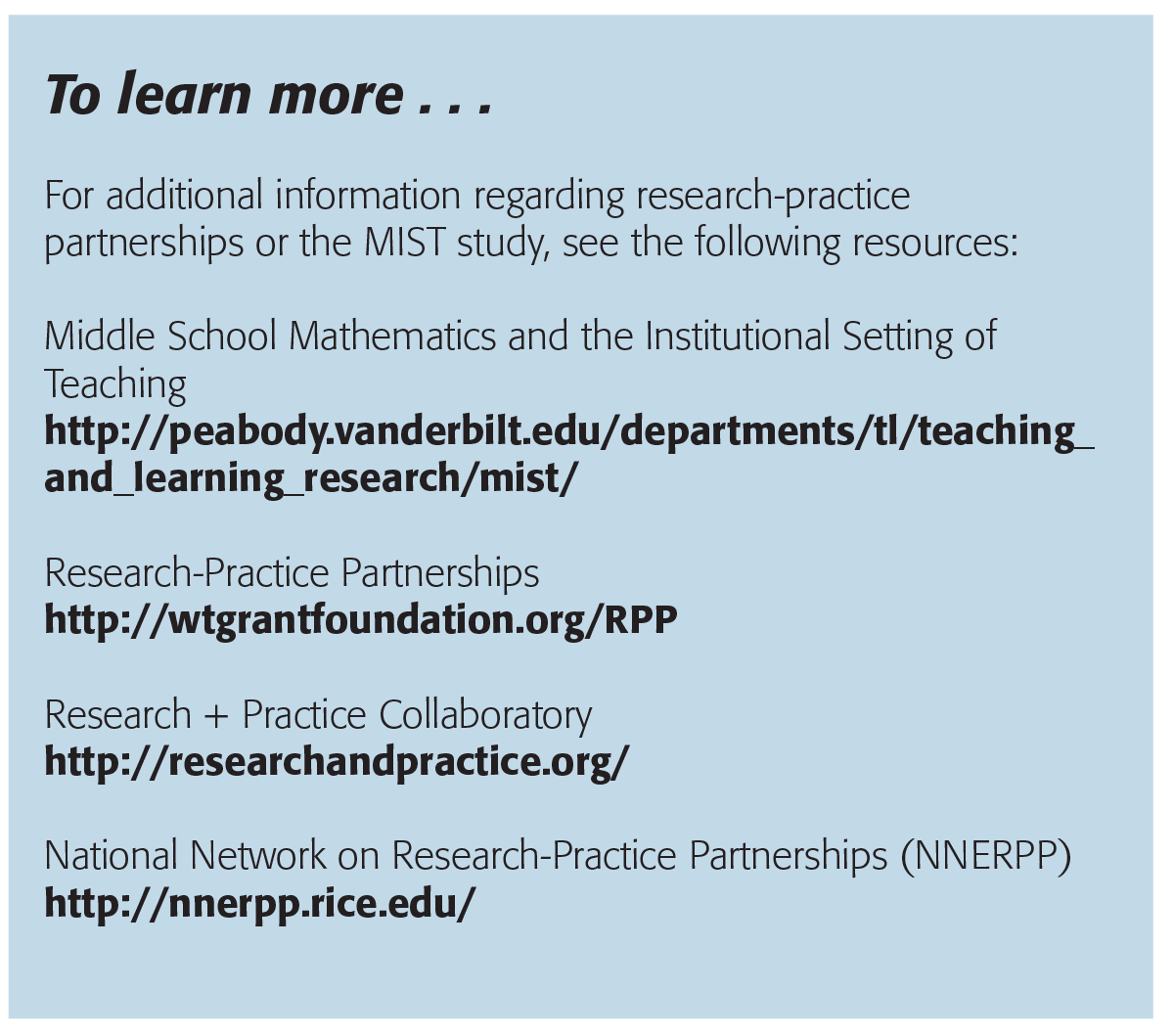
By focusing on real-time district challenges, collaborations between researchers and district leaders can lead to research that is timely, relevant, and actionable.
Research organizations have been working in school districts for decades. But how useful and relevant has that research been for practitioners? Currently, policy makers and funders are scrutinizing these relationships to tackle that question.
Several weak spots in the relationship need shoring up. District leaders often feel that working with researchers is not mutually beneficial. Researchers may not provide enough practical guidance to inform decision making. Often, research is not available when district leaders need it to make a decision nor is it shared with them in a useful manner. Typically, it’s steeped in academic language, and it emphasizes theory and methodology over specific recommendations. As district leaders work on complex problems of practice and simultaneously manage accountability pressures and declining resources, research work must directly support their mission to improve schools.
An emerging format for addressing these challenges is through research-practice partnerships (RPPs). These are “long-term, mutualistic collaborations between practitioners and researchers that are intentionally organized to investigate problems of practice and solutions for improving district outcomes” (Coburn, Penuel, & Giel, 2013, p. 2). By focusing on real-time district challenges, RPPs can lead to research that is more informative, timely, and relevant to district stakeholders.
Two different relationships
There are major differences between traditional relationships among researchers and school districts and those that characterize RPPs. We ground this discussion in our shared experiences as university researchers and a district leader working together on an eight-year research-practice partnership. We’ve adapted our work to support productive partnerships, and we proffer some recommendations for district leaders and researchers interested in engaging in an RPP.
The traditional relationship
Researchers conduct research in school districts all over the United States. Typically, researchers seek district sites for data collection to test hypotheses, develop or refine theories, or test programs or interventions. In most cases, researchers submit a research proposal to the research and evaluation department of a school district. If the application is approved, the subsequent interaction between the district and the researchers usually is minimal. District staff might assist in connecting the researcher with the appropriate personnel or providing researchers with district-collected data (for example, student achievement test data). Researchers may be asked to provide a report to the district research office, which is usually filed away with their initial application.
For the most part, these low-involvement relationships are not mutually beneficial. Researchers might work closely with study participants, but there are seldom mechanisms for district leaders to learn from the research. Further, researchers typically don’t engage with leaders to collectively interpret the findings and answer questions that might arise.
The research-practice partnership
In contrast, RPPs use intentional strategies to foster productive relationships between researchers and district leaders so that research is relevant and meaningful to all involved. Researchers collaborate with district leaders to support district improvement efforts while also contributing to research and theory. In an RPP, district leaders and researchers collaboratively determine research goals and work together to use research findings to make informed decisions.
To illustrate this type of collaboration, we describe an eight-year design research partnership between Jefferson County Public Schools (JCPS) in Louisville, Ky., and researchers at Vanderbilt University. Design research partnerships at the district level are long-term collaborations that seek to “build and study solutions at the same time in real-world contexts” (Coburn et al., 2013, p. 8).
A closer look: The MIST research-practice partnership
In the Middle School Mathematics and the Institutional Setting of Teaching (MIST) study, researchers supported efforts of their partner districts to improve middle school mathematics instruction and develop students’ conceptual understanding and procedural fluency. MIST’s work followed standards set by the National Council of Teachers of Mathematics and by recent adoption of state standards, such as the Common Core State Standards.
The MIST study worked with four large urban districts, including Jefferson County Public Schools. JCPS is the 27th-largest school district in the United States and has more than 150 schools serving about 100,000 students. JCPS serves a high percentage of at-risk urban students with high poverty levels. Over 60% of its students qualify for free or reduced-price lunch. JCPS was already implementing several districtwide strategies to improve the quality of mathematics instruction when the partnership was established. The district’s improvement strategies included:
- Developing principals as instructional leaders;
- Supporting teachers’ use of rigorous instructional materials to develop students’ problem-solving skills and understanding of math concepts; and
- Developing productive school-level professional learning communities (PLCs) that focus on using data to make decisions regarding instructional planning and supporting struggling students.
JCPS district leaders wanted feedback and guidance on how their efforts were working on the ground, and researchers wanted opportunities to study how to improve mathematics instruction on the scale of a large urban district. Two key dimensions of the partnership benefited both researchers and district leaders.
Providing yearly feedback to support improvement
Each fall, researchers documented the district’s priority improvement strategies by interviewing key district leaders and writing a four- to five-page District Design Document. Each winter, the researchers collected data to document the quality of middle-grades mathematics instruction in the district and assess how teachers were actually implementing the district’s key improvement strategies. Each May, researchers gave district leaders a 10- to 15-page Feedback and Recommendation Report that shared findings on the quality of the district’s mathematics instruction, on teachers’ math content knowledge, on how the improvement strategies were playing out across the district, and on possible improvements.
Feedback meetings on the report offered a unique opportunity for open dialogue among people with diverse perspectives and expertise. For example, instructional coaching was discussed nearly every year. One year, the district changed the instructional coaching model from a district-based content specific coaching model to a school-based generalist coaching model. Researchers shared findings emphasizing the content-specific expertise required to support instructional improvement in mathematics. District leaders emphasized moving resources out of the district office into schools and supporting best practices that were not content specific. Researchers and district leaders valued the opportunity to engage in honest conversation about the research findings and their implications for future improvement strategies. This genuine partnership activity built trust among team members; over the eight-year partnership, the meetings became a cornerstone of the collaboration.
Researchers and district leaders valued the opportunity to reflectively engage in honest conversation about the research findings and the implications for future improvement strategies.
Providing annual feedback on district improvement efforts also supported MIST’s research goal of developing a comprehensive theory of action for improving the quality of mathematics instruction at scale. Over eight years, the research team wrote 24 Feedback and Recommendation Reports. Based on the findings, we identified concrete practices that support improvement in mathematics instruction. For example, we knew instructional leadership mattered for instructional improvement, but this work enabled us to detail specific routines and practices for school leaders, such as observing a math lesson with an instructional coach and discussing the nature of feedback and supports that would most benefit the teacher.
Codesigning professional development
MIST researchers and JCPS district leaders participated in additional collaborative activities to support the mathematics improvement effort. We engaged in two-day summer institutes to examine the district’s research findings in view of developing an aligned professional development plan for school leaders, math instruction coaches, and teachers for the upcoming year. Researchers and the math specialist jointly designed and led professional development activities to support district leader capacity to design professional development. Participants set goals for the meetings, planned each session, and analyzed meetings afterward to inform the design of subsequent sessions. Topics addressed during the partnership included professional development for instructional leaders on important aspects of math instruction linked to student learning, including the rigor of the math task and quality of classroom discussion.
This process supported the development of district leader capacity and gave researchers opportunities to investigate and refine professional development designs to effectively support district leaders, instructional coaches, and school leaders in their work with mathematics teachers.
New ways of working together
The collaborative activities we’ve described differ from what typically occurs when researchers work in school districts. MIST researchers and JCPS district leaders both had to adapt their typical practices to engage in effective partnership work. Here are some lessons learned about supporting partnership activities.
Coordinate research and district timelines
University researchers and district leaders typically operate on different timetables. District leaders often need to make decisions based on requirements set by the school calendar, the school board, the budget cycle, and state accountability requirements. It’s crucial for researchers to consider these constraints. If a decision has to be made by a certain time in the school year, researchers can incorporate this deadline into their data collection and analysis while continuing to produce empirically solid findings. For example, MIST researchers had to develop a process for analyzing a large number of audio-recorded interviews of teachers, coaches, school leaders, and district leaders. They had to do this quickly and accurately in order to produce trustworthy findings to present in May before district leaders began to plan for the next school year.
Allocate ample time for ongoing meetings
District leaders have many obligations and deadlines, and they often need to respond to unanticipated crises, making it challenging to regularly schedule significant blocks of time to participate in partnership work with researchers. Conversations between researchers and district leaders around relevant research findings build district leaders’ capacity to interpret and use research. Likewise, deep partnerships with district leaders give researchers insights into the challenges these leaders face when attempting to make systemwide improvements in complex education settings, particularly in high-needs priority schools.
District leaders can support this work by assigning personnel to coordinate and lead RPP work and by scheduling time for researchers and key district personnel to engage in collaborative activities that involve interpreting and using research. For example, in the MIST study, JCPS assigned a senior staff member in the math department as project liaison, making the partnership a part of the day-to-day work of the district.
Embrace uncertainty
Partnership activities often require district leaders and researchers to work in nontraditional ways that can feel messy or unclear. For example, determining the focus of partnership work requires negotiation between partners. Penuel and colleagues (2015) explain that “both district goals for improvement and aspects of the research are defined and evolve through interaction, rather than being planned fully ahead of time or defined by either researchers or practitioners independently of one another” (p. 183). Oftentimes, researchers participating in RPPs need to be nimble to adjust their research focus and methodologies to address district problems. For example, in the MIST study, researchers interviewed district leaders at the beginning of each school year to understand any changes related to the district’s strategy to improve mathematics instruction. As district improvement goals and strategies in JCPS changed over time, MIST researchers adjusted the data collection instruments to provide the district with relevant feedback on those improvement strategies.
Are you ready?
Members of the MIST partnership identified three actions that district leaders and researchers can take to assess their own and their prospective partner’s readiness to engage productively in an RPP.
#1. Establish a trusting relationship.
Is there an existing relationship between researchers and district personnel? If not, consider collaborating on a small-scale project to begin building trust and establishing effective ways of working together.
If a relationship between researchers and district personnel already exists, what can be done to further strengthen these connections and improve collaboration? Consider participating in a “value-mapping activity” with partners to share diverse perspectives around an identified district problem, such as improving student achievement in mathematics in our case. Researchers and district leaders need to understand everyone’s perspective on why improving student achievement in mathematics was important and what would be required to improve student achievement in mathematics and prepare students to be successful, not just on the state assessment, but for college and career. Such discussions help develop a shared understanding of the problem and potential solutions (Ryoo & Shea, 2015).
#2. Assess district commitments and priorities.
Are district leaders committed to developing district capacity to use research when making decisions to improve teaching and learning? Consider adding a specific goal to the district’s strategic plan that emphasizes the development of district capacity to use research.
Are district leaders committed to prioritizing and allocating time and resources for partnership activities? Consider identifying a district liaison to coordinate and support partnership work between school district personnel and researchers.
#3. Assess researcher commitments and priorities.
Are the researchers committed to investigating critical problems of practice? Consider engaging in ongoing dialogue with potential research partners to develop a shared understanding of commitments and values.
Do the researchers have the time and resources available to address the goals of the partnership? Matching resources with the scope of the partnership activities increases the potential for long-term success.
Learning from each other
District leaders and researchers need to work together to improve the quality of teaching and learning in the most productive manner possible. This requires changing the traditional ways of doing research. Although engaging in RPP work requires district leaders and researchers to adjust their current ways of working together, the benefits are well worth it. Vivian Tseng (2012), vice president of the W.T. Grant Foundation, emphasizes that creating a new space for this kind of collaborative work requires us to abandon the “research to practice” metaphor and, instead, view this work as bidirectional, with researchers and district leaders capitalizing on their complementary areas of expertise — learning from each other and forging new ways to improve schooling. Developing trusting, collaborative relationships between researchers and district leaders directed toward common goals can energize efforts to improve educational opportunities for all students.
As more researchers and district leaders engage in research-practice partnerships, our understanding of productive ways of working together to support school improvement will continue to grow. It’s our joint responsibility to promote new ways of working within both organizations to support the development of successful partnerships.
For example, district leaders can streamline the amount and focus of improvement initiatives in their districts to provide the time and capacity needed to prioritize RPP work. Researchers can advocate for doctoral training programs to support the development of the skills and expertise needed to conduct partnership work, as well as call for changes in professional expectations of educational researchers to acknowledge and reward engaging with school districts in this manner. In addition, researchers can further support the development of the field by studying the effect and outcomes of RPPs to assess how and under what conditions RPPs contribute to educational improvement.
Based on our experiences in large urban districts, RPPs can facilitate the development of relevant, actionable research and its use within the practitioner community without sacrificing the rigor of the academy. The rich benefits of RPPs outweigh their challenges. They provide a common ground for school districts and researchers to make informed decisions about how best to proceed.

References
Coburn, C.E., Penuel, W.R., & Geil, K.E. (2013). Research-practice partnerships: A strategy for leveraging research for educational improvement in school districts. New York, NY: William T. Grant Foundation.
Penuel, W.R., Allen, A.R., Coburn, C.E., & Farrell, C. (2015). Conceptualizing research–practice partnerships as joint work at boundaries. Journal of Education for Students Placed at Risk, 20 (1-2), 182-197.
Ryoo, J. & Shea, M. (2015). Activity: Mapping shared goals and outcomes in a partnership. http://researchandpractice.org/resource/value-mapping
Tseng, V. (2012). Partnerships: Shifting the dynamics between research and practice. New York, NY: William T. Grant Foundation.
Citation: Henrick, E. and Muñoz, M.A., & Cobb, P. (2016). A better research-practice partnership. Phi Delta Kappan, 98 (3), 23-27.
ABOUT THE AUTHORS

Erin Henrick
ERIN HENRICK is project manager and coprincipal investigator of the Middle School Mathematics and the Institutional Setting of Teaching study at Vanderbilt University, Peabody College, Nashville, Tenn.

Marco A. Munoz
MARCO A. MUÑOZ is director of priority schools at Jefferson County Public Schools , Louisville, Ky., and a member of the senior JCPS cabinet.

Paul Cobb
PAUL COBB is principal investigator for the MIST project and a professor of mathematics education at Vanderbilt University.










